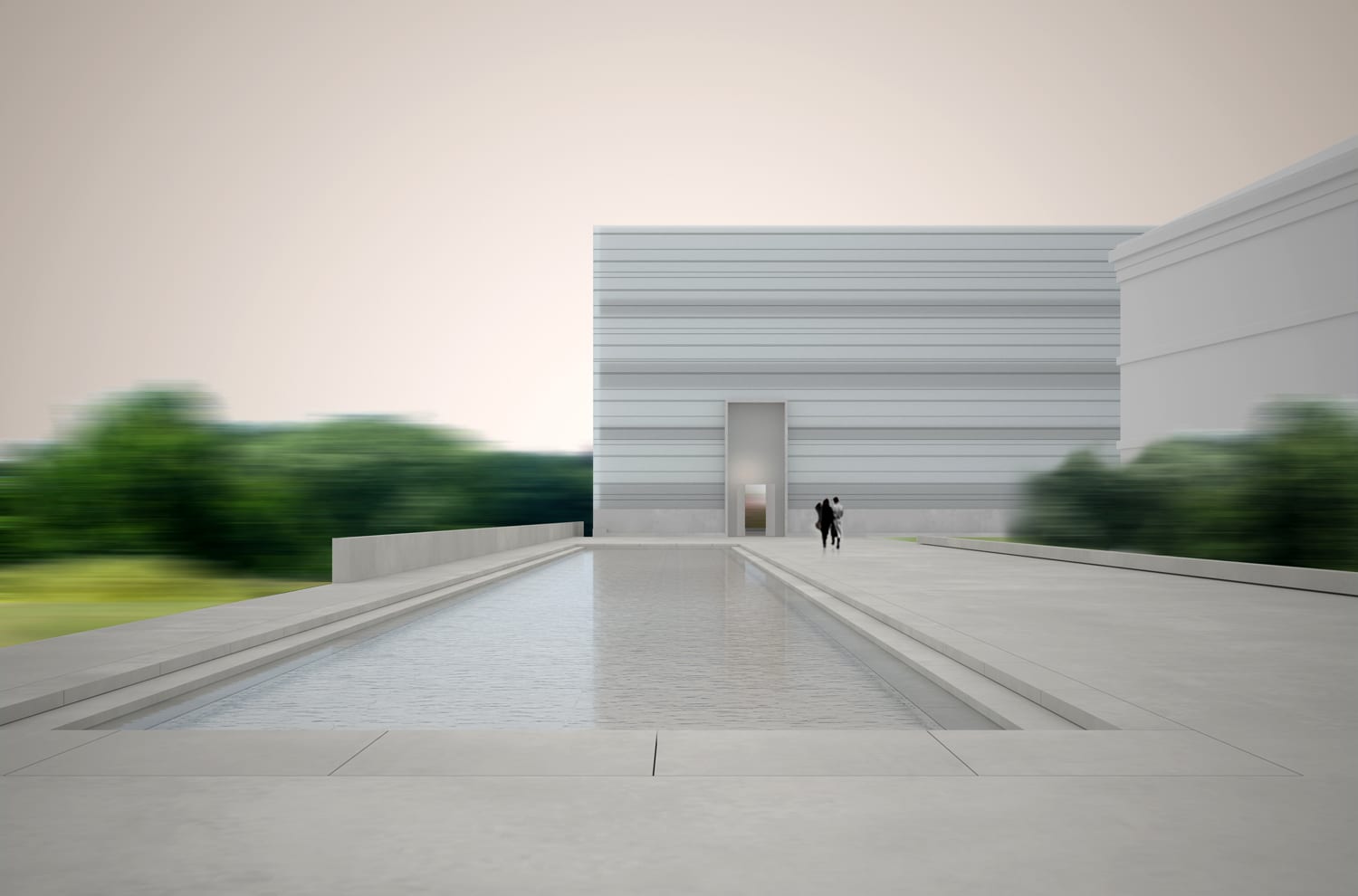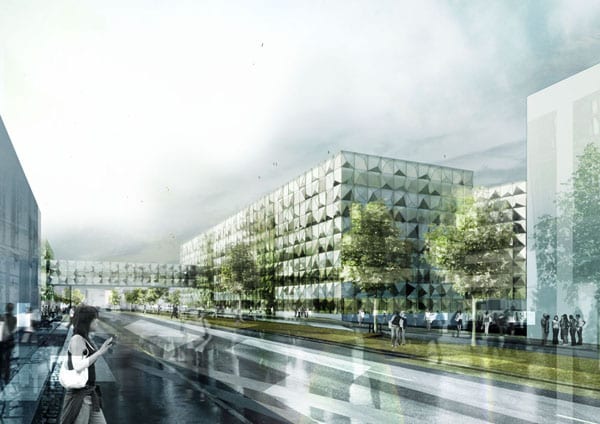Slovenian Architects Dominate the International Ljubljana Library Competition by Stanley Collyer
Winning entry by Bevk Perović Arhitekti d.o.o. Locating the new National and University Library NUKI II in the heart of historic downtown Ljubljana on a highly visible corner site was itself a major challenge for architects entering this competition. Of the 120 entries from throughout the world received, 116 were admitted for adjudication. Almost half of the designs submitted were of Slovenian origin, with foreign submissions heavily represented by entries from other European countries. One might have assumed that such a high profile international competition would have attracted even more entries. However, the stipulation that a physical model be part of the package must have given many architects pause. Such a requirement may not have been viewed as a serious obstacle for architects residing in the European Community. But, for those living outside of the EU, mailing costs and concerns about getting such a package through Slovenian customs on time undoubtedly reduced participation. Weimar's New Bauhaus Museum: Shedding New Light on a Storied Architectural Tradition
by Dan Madryga Winning entry by Heike Hanada with Benedict Tonon Is a museum collection only as good as the architecture that houses it? With the glut of contemporary museum design producing world-class buildings for even the most mundane of collections, that seems to be the consensus of the age. Yet there is no doubt that when a museum collection is distinguished enough, it can benefit from a well-designed container. The Bauhaus Museum in Weimar, Germany boasts just the sort of outstanding collection in need of a better home. Since 1995, the museum has been housed in an art museum on Theaterplatz that incorporates Clemens Wenzeslaus Coudray’s 19th century classicist Kulissenhaus. As a piece of architecture it is not a bad building, but it is certainly a laughably incongruent style for one of the most influential modernist schools of the 20th century. Fortunately, this mish-mashed arrangement was always intended to be temporary, and this summer, an intriguing museum design was selected as a permanent home through the New Bauhaus Museum Competition.
Reimagining a Decaying Industrial Site:
Nashua Master Plan Design Competition
by Stanley Collyer
Winning entry by Carl Pucci & Efrain Carbaca
Nashua, New Hampshire is no different than many of its neighbors in New England: with the closing of its mills, it is the site of a post industrial district needing rejuvenation and new ideas. With this in mind, the City decided to stage a one-stage design competition to find some creative solutions to this problem.
Small Hospitals, Big Ideas: Kaiser Permanente Looks to New Health Care Solutions by Larry Gordon
Winning entry by Aditazz Medical technology and health care economics are being revolutionized. Meanwhile, both patients and doctors want hospitals to be more beautiful and humane places. And everyone hopes health facilities will become more environmentally sustainable. With all that in mind, the enormous health care provider system Kaiser Permanente last year launched an ambitious competition for architects to design a small 100-bed hospital of the future. While a possible site would be in the high desert California community of Lancaster, the contest was really looking for a prototype that could be adapted in many settings, rural, suburban and city. After all, Kaiser Permanente already serves 8.7 million members in nine states and the District of Columbia and is growing.
A Human Touch in an Age of High Technology:
The Nils Bohr Science Park in Copenhagen
by Stanley Collyer
Winning entry by Rambøll
How to express an idealistic learning environment in terms of bricks and mortar is hardly new. Frank Gehry’s Stata Center at M.I.T. in Cambridge, Massachusetts is a recent example of the effort to encourage creative thinking by design at the post-graduate level. The University of Copenhagen in Denmark has taken up this idea by challenging a select group of architects to design the new Nils Bohr Science Park. They envision a ‘limitless community’ of academics and students, with lots of cross-pollination between disciplines. Performance Takes Top Priority:
Cultural Center Guy-Gagnon in Verdun, Quebec
by Stanley Collyer
Winning entry by Les Architectes FABG
Les Architectes FABG won the competition for a new cultural venue, including a professional theater on the St. Lawrence River in the Verdun Borough of Quebec Province. The project also provides for redevelopment and expansion of Verdun's resident school for circus performance (École de cirque de Verdun).
Re-Shape History:
The Atlanta History Center Competition
by Stanley Collyer Winning entry by Pfeiffer Partners Architects, Final Stage Submission
As part of a $27.4M capital campaign to update its building and exhibition areas, the Atlanta History Center settled on a design competition as a model to seek innovative ideas, not only for a redo of its circulation problems, but also to deal with an arrival issue—an outdated entrance and foyer. A Dramatic Curtain: The Taiwan Tower International Competition
by Stanley Collyer 
Winning entry by Sou Fujimoto Architects
The sponsors of the Taiwan Tower Competition have managed to come up with a departure from a generic solution to an observation tower. Instead of settling on the ubiquitous column with a sphere on top, they picked a green solution by the Japanese architect, Sou Fujimoto, which simultaneously conveys the appearance of a giant theater curtain, ready to reveal the unfolding of an interesting drama. Instead of illustrating the bare bones of a support system, the structure is shrouded in mystery, and, aside from its character as a model of sustainability, it should draw crowds of curiosity seekers for decades to come. Read more...Bringing Life to the Center: The Aberdeen City Garden Competition by Stanley Collyer 
Winning entry by Diller Scofidio + Renfro
Aberdeen, Scotland has long been the beneficiary of the oil bonanza off its coast in the North Sea. But faced with declining oil revenues from this source, the community now finds itself at a crossroads: how do you reinvent yourself while a once dependable revenue stream is slowly disappearing? Urban issues logically came to the forefront, and the discussion concentrated on Aberdeen City Gardens, an underused park smack in the middle of the city. If this relatively dormant piece of real estate could be turned into a people place for the community and beyond, it might not only help to rejuvenate the city’s urban core, but provide it with an asset having a symbolic value well beyond that of a common green space. Read more...Improving Education by Design The 2011 Cleveland Design Competition
by Stanley Collyer Can reducing class size and hiring more qualified teachers be the only answer to improving our educational system? Not according to the goals set forth by the organizers of the most recent 2011 Cleveland Design Competition. This open contest challenged architects to come up with new ideas, keeping pace with “the continuing advancements in pedagogy, curricula and organization models.” In other words, why shouldn’t equal attention be devoted to the “reinvention of learning environments.” Read more...
|

Helsinki Central Library, by ALA Architects (2012-2018)
The world has experienced a limited number of open competitions over the past three decades, but even with diminishing numbers, some stand out among projects in their categories that can’t be ignored for the high quality and degree of creativity they revealed. Included among those are several invited competitions that were extraordinary in their efforts to explore new avenues of institutional and museum design. Some might ask why the Vietnam Memorial is not mentioned here. Only included in our list are competitions that were covered by us, beginning in 1990 with COMPETITIONS magazine to the present day. As for what category a project under construction (Science Island), might belong to or fundraising still in progress (San Jose’s Urban Confluence or the Cold War Memorial competition, Wisconsin), we would classify the former as “built” and wait and see what happens with the latter—keeping our fingers crossed for a positive outcome.
Read More…
Young Architects in Competitions
When Competitions and a New Generation of Ideas Elevate Architectural Quality

by Jean-Pierre Chupin and G. Stanley Collyer
published by Potential Architecture Books, Montreal, Canada 2020
271 illustrations in color and black & white
Available in PDF and eBook formats
ISBN 9781988962047
What do the Vietnam Memorial, the St. Louis Arch, and the Sydney Opera House have in common? These world renowned landmarks were all designed by architects under the age of 40, and in each case they were selected through open competitions. At their best, design competitions can provide a singular opportunity for young and unknown architects to make their mark on the built environment and launch productive, fruitful careers. But what happens when design competitions are engineered to favor the established and experienced practitioners from the very outset?
This comprehensive new book written by Jean-Pierre Chupin (Canadian Competitions Catalogue) and Stanley Collyer (COMPETITIONS) highlights for the crucial role competitions have played in fostering the careers of young architects, and makes an argument against the trend of invited competitions and RFQs. The authors take an in-depth look at past competitions won by young architects and planners, and survey the state of competitions through the world on a region by region basis. The end result is a compelling argument for an inclusive approach to conducting international design competitions.
Download Young Architects in Competitions for free at the following link:
https://crc.umontreal.ca/en/publications-libre-acces/

RUR model perspective – ©RUR
New Kaohsiung Port and Cruise Terminal, Taiwan (2011-2020)
Reiser+Umemoto RUR Architecture PC/ Jesse Reiser – U.S.A.
with
Fei & Cheng Associates/Philip T.C. Fei –R.O.C. (Tendener)
This was probably the last international open competition result that was built in Taiwan. A later competition for the Keelung Harbor Service Building Competition, won by Neil Denari of the U.S., the result of a shortlisting procedure, was not built. The fact that the project by RUR was eventually completed—the result of the RUR/Fei & Cheng’s winning entry there—certainly goes back to the collaborative role of those to firms in winning the 2008 Taipei Pop Music Center competition, a collaboration that should not be underestimated in setting the stage for this competition.
Read more…

Winning entry ©Herzog de Meuron
In visiting any museum, one might wonder what important works of art are out of view in storage, possibly not considered high profile enough to see the light of day? In Korea, an answer to this question is in the making.
It can come as no surprise that museums are running out of storage space. This is not just the case with long established “western” museums, but elsewhere throughout the world as well. In Seoul, South Korea, such an issue has been addressed by planning for a new kind of storage facility, the Seouipul Open Storage Museum. The new institution will house artworks and artifacts of three major museums in Seoul: the Seoul Museum of Modern Art, the Seoul Museum of History, and the Seoul Museum of Craft Art.
Read more…
Belfast Looks Toward an Equitable and Sustainable Housing Model

Birdseye view of Mackie site ©Matthew Lloyd Architects
If one were to look for a theme that is common to most affordable housing models, public access has been based primarily on income, or to be more precise, the very lack of it. Here it is no different, with Belfast’s homeless problem posing a major concern. But the competition also hopes to address another of Belfast’s decades-long issues—its religious divide. There is an underlying assumption here that religion will play no part in a selection process. The competition’s local sponsor was “Take Back the City,” its membership consisting mainly of social advocates. In setting priorities for the housing model, the group interviewed potential future dwellers as well as stakeholders to determine the nature of this model. Among those actions taken was the “photo- mapping of available land in Belfast, which could be used to tackle the housing crisis. Since 2020, (the group) hosted seminars that brought together international experts and homeless people with the goal of finding solutions. Surveys and workshops involving local people, housing associations and council duty-bearers have explored the potential of the Mackie’s site.” This research was the basis for the competition launched in 2022.
Read more…

Alster Swimming Pool after restoration (2023)
Linking Two Competitions with Three Modernist Projects
Hardly a week goes by without the news of another architectural icon being threatened with demolition. A modernist swimming pool in Hamburg, Germany belonged in this category, even though the concrete shell roof had been placed under landmark status. When the possibility of being replaced by a high-rise building, it came to the notice of architects at von Gerkan Marg Partners (gmp), who in collaboration with schlaich bergermann partner (sbp), developed a feasibility study that became the basis for the decision to retain and refurbish the building.
Read more…
|











































